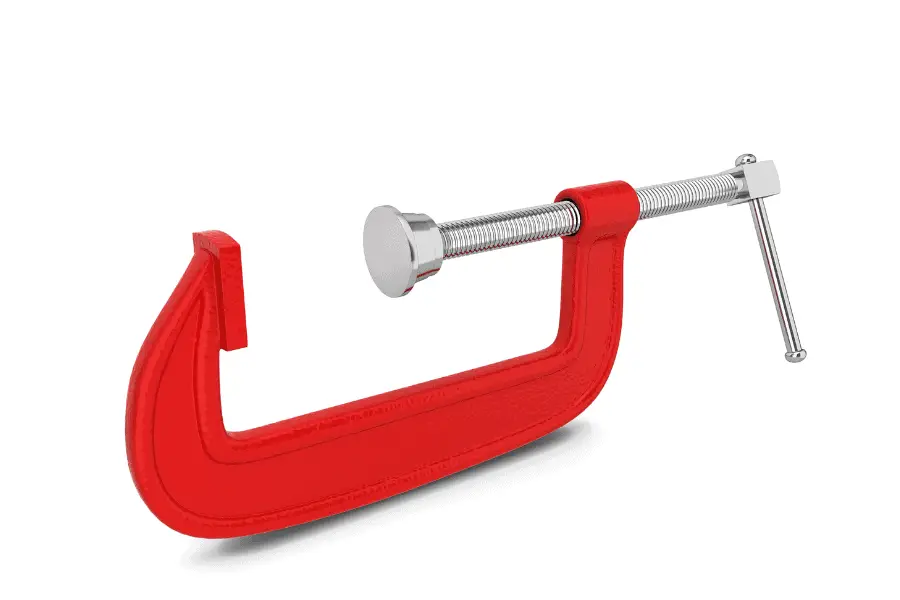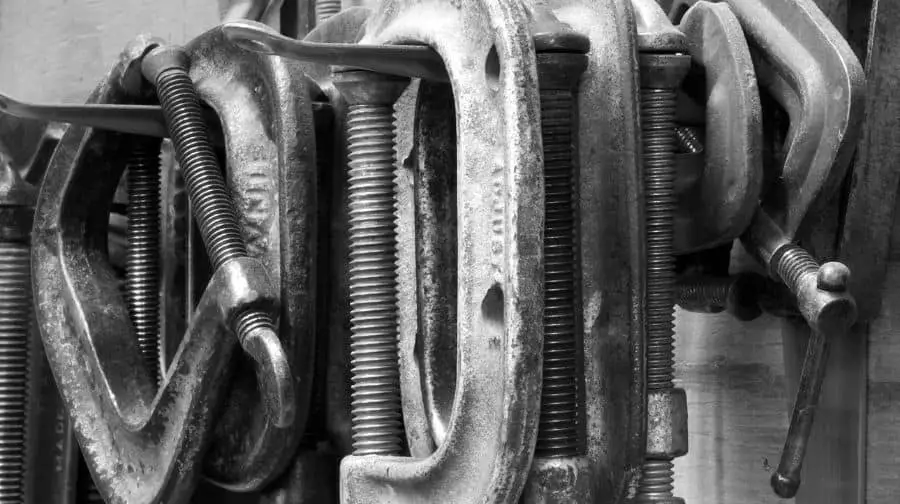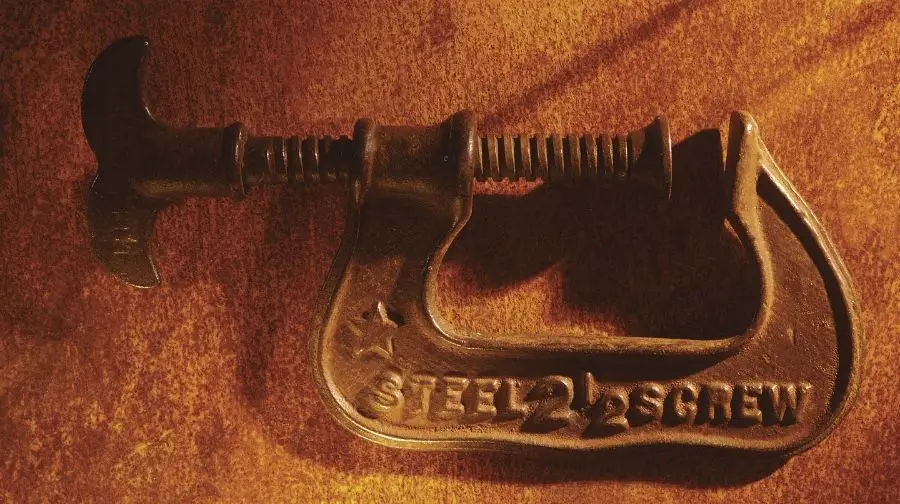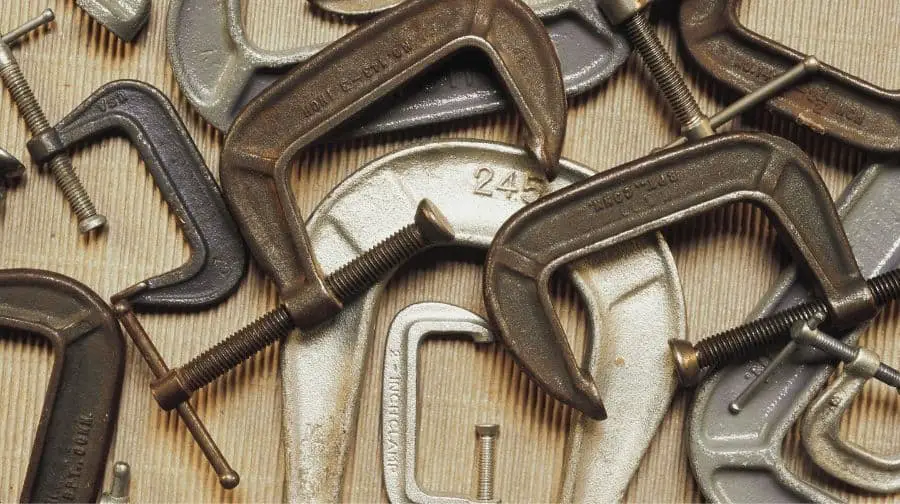
The C-clamp gets it’s name from it’s resemblance to the letter C and it’s a shortened version of it’s original name “Carriage Clamp.”
There are so many helpful options when it comes to clamps for your project. Each clamp has a specific purpose and function that separates it from the others. I’ve researched through the internet and put together a quick summary on C-clamps.
What is a C-clamp used for? C-clamps are commonly used in carpentry and woodworking to hold materials to the work surface while cutting or drilling is ongoing, and the C-clamp can also be used to hold joints together while they are glued.
Keep reading below to learn more about C-clamps and what they can be used for.
What Is A C-clamp?
A C-clamp is a type of clamping device that is used to hold a wood or metal workpiece, usually in carpentry or welding. It is a popular belief that C clamps are named after the resemblance between the look of the clamp and the letter “C”.
The C clamp is sometimes even referred to as the G-clamp because, when the screw is included, the clamp seems to look like the letter “G”. The clamp does indeed share similarities with these letters of the alphabet, but the C clamp was originally known as a Carriage Clamp, and the word “Carriage” has simply been shortened to just the letter “C”.
A C-clamp is made up of several different parts that enable it to hold the workpieces securely, including:
The Frame: The frame of the C-clamp is also referred to as the body. It is the main part of the clamp and therefore, it takes up the majority of the clamp’s area. The main purpose of the frame is to endure the pressure that is placed upon the workpiece while the clamp is being used.
The Jaws: The jaws of the C-clamp are the parts that do the actual gripping of the workpiece to hold the pieces together. The jaws of the C-clamp stand opposite one another, as one is stationary while the other jaw is moveable. This moveable jaw, which has a metal clamping plate, is adjusted using the screw so it can clamp workpieces of different sizes.
The Screw: A C-clamp also comprises a threaded screw that is used to control the movement of the adjustable jaw. The C-clamp makes use of the ACME form of a threaded screw, as the wider base of the thread makes the screw stronger than other types of screws. This ACME screw also gives the C-clamp a more secure grip on the workpiece.
The Handle: The handle of the C-clamp is connected to the screw and it is used to adjust the jaws of the clamp. To close the jaws of the clamp, the handle is first rotated clockwise till the screw is tightened, whereas the handle is rotated anti-clockwise to make the jaws open.
A C-clamp is also made up of a sliding pin handle that makes it easier to gain some extra leverage when the jaws of the clamp are being tightened. This sliding pin handle is normally made out of metal and it is connected to the screw by a collar.
C-clamps are typically made of steel or cast iron, although smaller versions of C-clamps may be made of pot metal. At the top of the clamp is typically a small flat edge while there is a threaded hole through which a large threaded screw protrudes on the bottom.
Discover 1,000 Hours Of Step-By-Step Woodworking Videos

It’s called Woodwork101. A database of detailed videos and blueprints in crystal clear, mouth-watering HD that will take you by the hand and show you that DIY home projects done the right way are easy, fun, and always of top quality… turning a dream into reality in a heartbeat. Getting you that perfect build each and every time.

Curious about What Is A Bar Clamp Used For? Please consider reading our article about the topic at this link here https://topwoodworkingadvice.com/what-is-a-bar-clamp-used-for/
How To Use A C-Clamp?
The C-clamp is used by turning the screw through the bottom of the clamp’s frame until the amount of pressure needed to hold the workpiece has been reached.
If the clamp is being tightened, then the workpiece being secured is fixed between the flat end of the screw and the flat end of the frame. However, if the clamp is being loosened, then an amount of force needs to be released to allow those fixed objects to be moved.
C-clamps, also known as G-clamps, comprise of a fixed width, C-shaped frames as well as adjustable hand screws that can be either tightened or loosened to secure the workpieces firmly.
Curious about What Are Corner Clamps Used For? Please consider reading our article about the topic at this link here https://topwoodworkingadvice.com/what-are-corner-clamps-used-for/
[Video] 3 Most Common Mistakes
When Setting Up Shop

A woodworking friend of mine shared this video by Ralph Chapman with me that helped him set up his workshop.
The video explains the benefits of Ralph Chapman’s guide about setting up an affordable workshop and avoiding the most common mistakes offers to anyone interested in woodworking.
How to Use a C-Clamp
Subscribe to Sikana English on Youtube

What Is A C-Clamp Used For?
These clamps are commonly used in carpentry and woodworking to hold materials to the work surface while cutting or drilling is ongoing, and the C-clamp can also be used to hold joints together while they are glued.
C-clamps can also be used in metalworking applications such as welding or grinding. The frame of the clamp is typically metallic, which makes it very durable as well as warp-resistant.
While a C-clamp serves a major purpose in woodworking, there should be special care and precautions taken when working with any wood pieces. The flat gripping ends of the clamp’s frame could also cause indentations and marring of the surfaces that are clamped.
This marring can be prevented by buffering between the clamp and the timber using two pieces of scrap wood. As the scrap woods stand between the workpiece and direct contact from the flat edges of the frame, these scrap woods, receive the damage from the edges, thereby prevent the workpiece from being harmed while still allowing the clamping force to be spread evenly across the workpiece.
The C-clamp is without a doubt, one of the most popular and common types of clamps, and the C-clamp is widely used by both professionals and DIYers alike.
The simplicity and availability of the C-clamp is the reason why it is so widely used, and due to its popularity, various designs are made available for different needs. These include:
The standard C-clamp: This is the regular C-clamp and it is the most commonly used out of the different types.
Double Anvil C-clamps: Double anvil C-clamps comprise of twin pressure points that help to distribute the pressure from the clamp evenly on workpieces which reduces the possibility of the workpieces being damaged.
Quick-release C-clamps: The quick-release C-clamps feature a quick mechanism that helps to make adjustments on the clamp quick and easy. These clamps can be used to hold the workpieces firmly for work such as gluing, welding, nailing, bending, cutting, and filling to be done.
Copper coated C-clamps: These are also referred to as Spatter resistant C-clamps as they are made up of copper-plated forcing screws and pads that help to resist welding spatter. They are typically hot-forged for strength and hard use.
Deep Reach C-clamps: These clamps are sometimes called long-reach clamps as they feature an extended throat design that can help in applying clamping pressure near the center of the material for its added stability.
Locking C-clamps: The locking C-clamps are built for one-handed use and comprise a classic trigger release that is designed to provide the maximum locking force.
All metal parts of the C-clamps should be kept clean and free from rust by oiling it properly and regularly. The C-clamp is a standard tool that should be found in every workshop or DIY Kit. It makes work with wood and metal much easier.

Curious about What Are Quick Grip Clamps Used For? Please consider reading our article about the topic at this link here https://topwoodworkingadvice.com/what-are-quick-grip-clamps-used-for/
